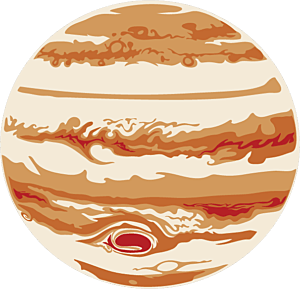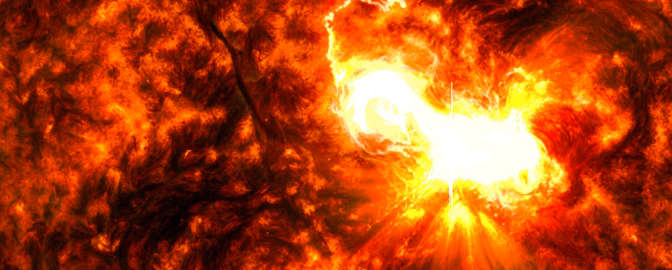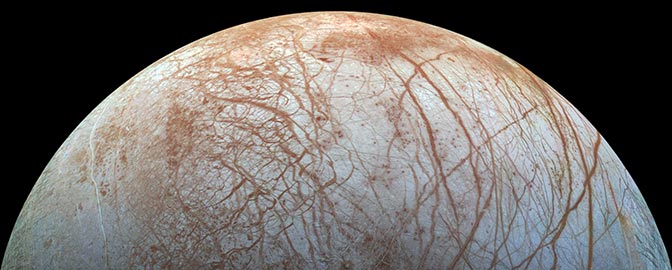The Downlink • Mar 21, 2025
Whole new (or newly discovered) worlds
Space Snapshot

Saturn’s family of moons is officially even bigger. The International Astronomical Union recently recognized the discovery of 128 new moons around Saturn, bringing its total to 274. This image of Saturn from NASA’s Cassini spacecraft shows two previously discovered moons, Mimas (to the left of the rings) and Tethys (to the right). Image credit: ASA/JPL-Caltech/Space Science Institute/Jason Major.
Fact Worth Sharing

Saturn’s 274 moons amount to more than the total number of known moons around all the other planets combined. The ringed planet has nearly three times as many known moons as the next most moon-adorned planet, Jupiter.
Mission Briefings


Researchers may have found four planets around the Sun’s second-nearest star system. Barnard’s star is only six light-years away from the Solar System, but exoplanet researchers have had a hard time confirming whether it hosted any planets. A new paper shares evidence that the star may actually have four planets in orbit around it. Pictured: An artist’s impression of the view from one of Barnard’s star’s planets. Image credit: International Gemini Observatory et al.

NASA astronauts Butch Wilmore and Suni Williams are safely back on Earth. After what was meant to be an eight-day mission turned into nine months stranded on the International Space Station, the two astronauts finally returned home on March 18 aboard a SpaceX capsule.

China is inviting international cooperation in its Mars sample return mission. The China National Space Administration has invited international contributions of science payloads to the Tianwen-3 mission, scheduled to launch a Mars lander and ascent vehicle in 2028, and an orbiter and Earth return vehicle later that year or in 2029.

NASA’s SPHEREx astrophysics observatory launched on March 11. The mission will conduct an all-sky spectral survey to study other galaxies and stars in the Milky Way and to understand the origins of the Universe.

Supernovae may have triggered at least two major extinction events on Earth. The existential threat of exploding stars seems a little more frightening after the discovery that the rate of nearby supernovae aligns with the timings of two major extinction events 372 and 445 million years ago. The energy released by supernovae could have temporarily stripped Earth’s atmosphere of ozone, exposing life to dangerous high-energy solar radiation and leading to the extinction of large portions of the world’s species.
From The Planetary Society


Join us for a special Planetary Radio live event. On March 24, Planetary Radio: Space Policy Edition will come to Washington, D.C., for a free, special live event. Hosts Sarah Al-Almed, Casey Dreier, and Bill Nye will be joined by other special guests to discuss the future of space politics under new congressional and White House leadership. Tickets are available now and Planetary Society members can submit discussion questions in advance in our online member community. Can't make it to D.C.? We'll share a video recording after the event.

This week on Planetary Radio: Mars innovation and changes at NASA. The latest episode of our weekly podcast brings you to the Mars Innovation Workshop, where cross-disciplinary collaboration is shaping the future of Mars exploration and creating solutions for challenges here on Earth. We also chat with Jack Kiraly, our director of government relations, about the recent announcement that NASA is shutting down some key advisory offices, including the Office of the Chief Scientist and the Office of Technology, Policy, and Strategy. Listen now.

Our Day of Action is happening this Monday. On March 24, Planetary Society members from across the country will meet with their congressional representatives in Washington, D.C., to advocate for space. This year we had a record-breaking 132 registrants. You can take action from home too. It’s more important than ever to speak up for space.

New gala ticket price: save $100! A generous donor has stepped in to help underwrite our Cosmic Shores Gala taking place on April 5 aboard the HMS Queen Mary in Long Beach, California, to celebrate our 45th anniversary. This means we are now able to offer tickets at a reduced rate of $150 per person. That’s $100 off the original ticket price! It’s sure to be a night you’ll never forget – surrounded by your fellow space enthusiasts. Please be sure to RSVP and purchase your tickets to attend before tickets are sold out!
What's Up

This week, look for super bright Venus very low to the eastern horizon shortly before dawn. In the evening, Jupiter shines very brightly high in the sky, with reddish Mars a bit higher to the east. Learn more at planetary.org/night-sky.
Wow of the Week

This painting by Planetary Society member Amy McCullough is titled "Without Horizon." It depicts a galaxy, inspired by images captured by the Hubble Space Telescope, JWST, and astrophotographers. It reminds us that as humanity continues to advance our ability to discover what’s out there, the Universe will continue to deliver. Image credit: Amy McCullough.
Send us your artwork!
We love to feature space artwork in the Downlink. If you create any kind of space-related art, we invite you to send it to us by replying to any Downlink email or writing to [email protected]. Please let us know in your email if you’re a Planetary Society member!


 Explore Worlds
Explore Worlds Find Life
Find Life Defend Earth
Defend Earth


